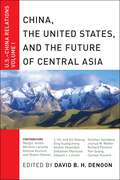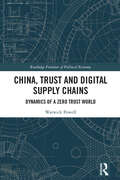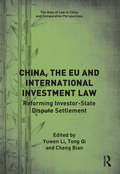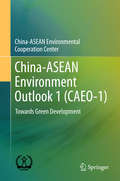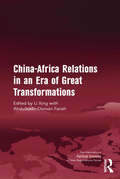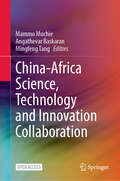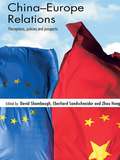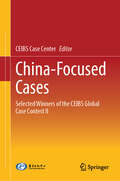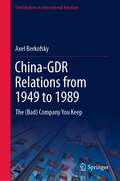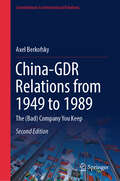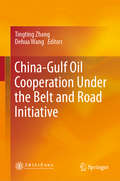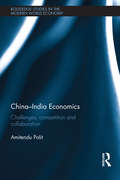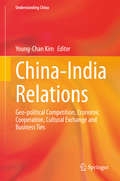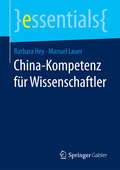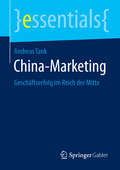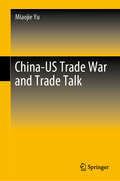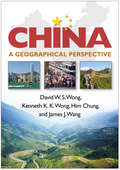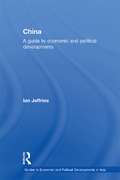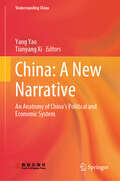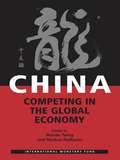- Table View
- List View
China, The United States, and the Future of Central Asia: U.S.-China Relations, Volume I (U.S.-China Relations #1)
by David B. H. DenoonThe first of a three-volume series on the interaction of the US and China in different regions of the world, China, the United States, and the Future of Central Asia explores the delicate balance of competing foreign interests in this resource-rich and politically tumultuous region. Editor David Denoon and his internationally renowned set of contributors assess the different objectives and strategies the U.S. and China deploy in the region and examine how the two world powers are indirectly competitive with one another for influence in Central Asia. While the US is focused on maintaining and supporting its military forces in neighboring states, China has its sights on procuring natural resources for its fast-growing economy and preventing the expansion of fundamentalist Islam inside its borders. This book covers important issues such as the creation of international gas pipelines, the challenges of building crucial transcontinental roadways that must pass through countries facing insurgencies, the efforts of the US and China to encourage and provide better security in the region, and how the Central Asian countries themselves view their role in international politics and the global economy. The book also covers key outside powers with influence in the region; Russia, with its historical ties to the many Central Asian countries that used to belong to the USSR, is perhaps the biggest international presence in the area, and other countries on the region’s periphery like Iran, Turkey, Pakistan, and India have a stake in the fortunes and future of Central Asia as well. A comprehensive, original, and up-to-date collection, this book is a wide-ranging look from noted scholars at a vital part of the world which is likely to receive more attention and face greater instability as NATO forces withdraw from Afghanistan.
China, Trust and Digital Supply Chains: Dynamics of a Zero Trust World (Routledge Frontiers of Political Economy)
by Warwick PowellChina, Trust and Digital Supply Chains presents a critical reflection on blockchain technologies in the context of their adoption in China and the world that China is engaged in and shaping. Approaching the issues of blockchain technology adoption and development on China’s own terms is critical if policy makers and others are to make effective sense of one of the key dynamics shaping the next few decades of the global landscape. The work challenges the ‘trust’ trope that dominates much discussion of blockchain technology’s application. It argues, contrary to the predominant trust trope, that blockchain is not about trust at all. It shows that China’s re-imagining of the 21st century global order is premised on driving intensified cross-border economic interactions without the presupposition of trust, and blockchain technology makes that possible. It also explores the paradox of technological decentralisation being taken up with vigour by a centralist polity, the role of blockchain technology as a critical condition of existence for the successful globalisation of China’s digital currency initiative, and the need to devise governance institutions that are multilateral in nature, to reflect the multi-polar nature of decentralised information systems with domestic and cross-border permutations. This book is of significant interest to readers of political economy, public policy, blockchain technology and Chinese studies.
China, the EU and International Investment Law: Reforming Investor-State Dispute Settlement (The Rule of Law in China and Comparative Perspectives)
by Yuwen Li Tong Qi Cheng BianThis book provides an original and critical analysis of the most contentious subjects being negotiated in the China–EU Comprehensive Agreement on Investment (CAI). It focuses on the pathway of reforming investor-state dispute settlement (ISDS) from both Chinese and European perspectives in the context of the China–EU CAI and beyond. The book is divided into three parts. Part I examines key and controversial issues of the China–EU CAI negotiations, including market access, sustainable development and human rights, as well as comparing distinct features between the China–EU CAI and the China–US BIT. Part II concentrates on the institutional reform of investor-state arbitration with an extensive analysis of the EU’s approach to replacing the private nature of investment arbitration with the public nature of an investment court. Part III addresses the core substantive and procedural issues concerning ISDS, such as the role of domestic courts in investment dispute settlement, the status of state-owned enterprises (SOEs) as investors, transparency and the protection of victims in investment dispute resolution. This book will be of interest to scholars and practitioners in the field of international investment and trade law, particularly investment dispute settlement.
China-ASEAN Environment Outlook 1 (CAEO-1)
by China-ASEAN Environmental CooperationThis book presents a comprehensive analysis of the status and progress of China-ASEAN green development and examines the common development issues in China and ASEAN Member States (AMSs). It also explores development trends within the framework of global and regional environmental governance and discusses the approaches towards green development in China and AMSs, offering its own definition of green development and using a “pressure-state-response” (PSR) model to build a framework for assessing green development. The book includes typical policy measures and numerous practices for green development in China and AMSs in the form of tables, figures and boxes. Based on detailed analysis, it argues that the global 2030 Agenda for Sustainable Development brings significant opportunities to China and AMSs, that the ongoing pragmatic cooperation should be further advanced, and that a connection between the Belt and Road Initiative and green ASEAN Community should be established to achieve regional sustainable development. As such it furthers readers’ understanding of environment and development and practical policy advice for promoting China-ASEAN cooperation on environment and green development. Intended for decision makers from the government, business sector, and civil societies who are working to boost green development and China-ASEAN cooperation, it is also a valuable resource for government officials, researchers and non-experts interested in creating a balanced relationship between the environment and development.
China-Africa Relations in an Era of Great Transformations (The International Political Economy of New Regionalisms Series)
by Li Xing Abdulkadir Osman FarahThis collection juxtaposes a variety of approaches about China and Africa, and their interrelations seeking to go beyond early, simplistic formulations. Perspectives informed by Polanyi advance nuanced analysis of varieties of capitalisms and double-movements. It seeks to put contemporary China-Africa relations in critical, comparative context and in doing so, it will go beyond descriptions of inter-regional trade and investment, large- and small-scale sectors, to ask whether structural change is underway. Already it is apparent that the growing presence of China in Africa presents the latter with some novel options but whether these will generate a new embeddedness remains problematic. Highlighting the ’varieties of capitalisms’ in the new century, given the undeniable difficulties of extreme neo-liberalism in the US and UK by contrast, to the apparent ebullience of the emerging economies in the global South, this book examines such implications for international relations, international political economy, development studies and policies.
China-Africa Science, Technology and Innovation Collaboration
by Mammo Muchie Angathevar Baskaran Mingfeng TangThis open access book brings together researchers from a variety of disciplines to explore science, technology, and innovation cooperation between China and African countries by using different perspectives. The growing economic, technological, and scientific cooperation between Africa and China provides opportunities to jointly develop mechanisms to provide a skill base from discovery to creativity, invention, innovation, entrepreneurship and implementation for the benefit of both Africa and China. This book makes a significant contribution to the knowledge imagination understanding of the different dimensions of China-Africa STI cooperation and can reach out to all stakeholders with evidence-based research.
China-Europe Relations: Perceptions, Policies and Prospects
by David Shambaugh Eberhard Sandschneider Zhou HongThe fast-developing relationship between China and Europe has become one of the most important in international affairs. China-Europe Relations takes an innovative and insightful look at this phenomenon, examining: the state of Chinese studies in Europe and European studies in China the decision-making behind the EU’s China policy, and what the Chinese perceptions and assessments are of Europe that shape China’s Europe policy the recent rapid growth of bilateral commercial and technological relations the global context of the bilateral Sino-European relationship, in particular the interaction of China, the EU, and the United States prospects for the future evolution of these relationships. The most systematic and comprehensive study on the subject to date, written by a stellar team of international contributors from China, Europe and the US, China-Europe Relations will appeal to students, academics and policy makers alike who are interested in international relations, comparative foreign policy and Chinese and European politics.
China-Focused Cases: Selected Winners of the CEIBS Global Case Contest II
by Ceibs Case CenterThis book showcases a selection of award-winning cases from the Global Contest for the Best China-focused Cases. The contests held between 2018 and 2022 recognized 63 exceptional cases, 13 of which are in this publication. Each of the 13 cases has a unique focus. Some investigate how to capture value through new technologies and innovations or examine the intricate relationships between strategies, business models, and financial performance (examples include Freshippo, KFC China, Winner Technology, Geek+, and Alibaba vs. JD.com). Others analyze Chinese companies’ challenges when entering international markets and their strategic responses (Midea and SHEIN). Some delve into leadership, entrepreneurial management, family business succession, negotiation, and conflict management (EtonHouse, Antigal, Qiangda Chilli, and Dispute over Year-end Bonuses). Two cases discuss how social enterprises can better balance their social purposes with financial sustainability and how companies can integrate social and business innovation (Daddy Lab and AstraZeneca). These cases originate from Chinese and international business schools, highlighting global interest in China's business and management dynamics. Echoing the Chinese proverb, “A single spark can start a prairie fire,” we firmly believe that with collective efforts, more faculty members will recognize the value of the case method and the extensive opportunities of China-themed cases in global management education. We are committed to collaborating with them to meet the growing demand for diverse cases with global perspectives.
China-GDR Relations from 1949 to 1989: The (Bad) Company You Keep (Contributions to International Relations)
by Axel BerkofskyThis book provides an in-depth analysis of the relations between China and the German Democratic Republic (GDR) from 1949 to 1989. These relations were characterized by some “ups” but many more “downs,” e.g. when, in the early 1960s, the Soviet Union ordered its vassal state in East Berlin to begin treating its former socialist comrade and brother-in-arms as an adversary and indeed enemy. Drawing on a wealth of archival material, especially from the archive of the GDR’s ruling party, this book examines selected issues and elements of East German and Chinese domestic and foreign policy. In order to better grasp the nature and the historical context of the bilateral relationship, it offers detailed insights into the following aspects: 1. the bilateral “honeymoon period” from 1949 to the late 1950s, which was accompanied by the two parties supporting and applauding each other’s oppressive domestic and ill-fated economic policies, including Mao’s Great Leap Forward and the Cultural Revolution; 2. relations during the 1960s, when the “Sino-Soviet Split” defined the quality and level of bilateral animosities; 3. the 1970s, when Beijing replaced socialist comradeship with East Berlin with trade and aid from the US and West Germany; and 4. the resumption of Sino-East German relations in the 1980s and the subsequent period up to the Tiananmen Square protests and the collapse of the GDR in 1989. The book will appeal to historians, political scientists and scholars of international relations, as well as policymakers, diplomats, and others with an interest in this previously under-researched area.
China-GDR Relations from 1949 to 1989: The (Bad) Company You Keep (Contributions to International Relations)
by Axel BerkofskyThis book provides an in-depth and very lively analysis of relations between China and the German Democratic Republic (GDR) from 1949 to 1989. It is the first and only comprehensive and detailed analysis of East German-Chinese ties and interactions in English. Chinese-East German relations, which over the decades have experienced some "highs" but many more "lows". " Low points came to the fore in the early 1960s when the Soviet Union ordered its vassal state in East Berlin to treat its former socialist comrade and brother-in-arms in Beijing as an adversary and even an enemy. In fact, the "Sino-Soviet split" ensured that until the late 1980s East Berlin and Beijing were more likely to talk about each other than to talk to each other. The second revised and extended edition of the book draws on a wealth of East German archival material. These include documents and reports from the archives of the GDR's ruling Socialist Unity Party (SED), the notorious East German Ministry of State Security (Stasi), and the Ministry of Foreign Affairs. Together with extensive secondary literature and almost everything that was ever written about China in East German newspapers from the 1950s to 1990, this book examines selected issues and areas of East German and Chinese domestic and foreign policy, placing policies and interactions in their historical context. It offers very detailed and well-documented insights into the following aspects: 1. the bilateral "honeymoon period" from 1949 to the late 1950s, during which both sides supported and applauded each other's oppressive domestic economic policies, including Mao's Great Leap Forward and the Cultural Revolution; 2. the 1960s, when the "Sino-Soviet split" determined the quality and level of bilateral interactions and tensions; 3. the 1970s, when Beijing replaced socialist comradeship with East Berlin with trade and aid from the US and Germany; and 4. the resumption of bilateral relations in the 1980s. The 1970s, when Beijing replaced socialist comradeship with East Berlin with trade and aid from the US and West Germany; and 4. The resumption of Sino-German relations in the 1980s and the subsequent period up to the Tiananmen Square protests and the collapse of the GDR in 1989. The book will appeal to historians, political scientists and international relations scholars, as well as policymakers and diplomats interested in this under-researched area.
China-Gulf Oil Cooperation Under the Belt and Road Initiative
by Tingting Zhang Dehua WangThis book not only discusses how to further deepen the oil cooperation relations between China and the Gulf Council Countries in the context of “the Belt and Road Initiative”, but also investigates how to ensure the security of the entire oil supply chain including oil supply, oil transportation channels, oil demand, and petroleum reserves in China. Further, it examines a novel, win-win oil cooperation between China and the GCC countries, known as joint oil stockpiling. The results presented offer guidance for similar energy cooperation between China and other energy producing countries and also provide a new perspective on how to improve the research on and understanding of China’s energy security issues and multi-lateral energy cooperation issues, making the book of particular interest to engineers and scientists in the field of energy, international relations, and oil stockpiling enterprises.
China-India Economics: Challenges, Competition and Collaboration (Routledge Studies in the Modern World Economy)
by Amitendu PalitA review of the existing literature on the China-India comparative theme conveys the distinct impression that the literature largely projects China and India as intrinsically competitive entities. While much has been written on where and why China and India are contesting, particularly from a political sense, very little attention has been devoted to mutual collaboration, whether existing or potential. Such possibilities are at their greatest in economics, which will dominate the future China-India relationship. This book explores Sino-Indian ties from a comparative economic perspective and argues that it is erroneous to visualise the ties either from exclusively competitive or collaborative perspectives. The future relationship between the two countries will be characterised simultaneously by two ‘C’s: competition and collaboration, which are both linked to common challenges facing them. Arguing that while competition in the economic sphere is inevitable, given their size and aspirations, the book contends that negative externalities from competition will encourage both countries to collaborate and expand the scope of such collaboration. The book's refreshing angle makes it a must-read for those interested in Sino-Indian relationship.
China-India Relations: Geo-political Competition, Economic Cooperation, Cultural Exchange and Business Ties (Understanding China)
by Young-Chan KimThis book examines India-China relations throughout history as well as in the context of current business cooperation and competition. It also explores geo-political and societal factors, such as religion or class models, that influence and shape bilateral relations, and provides thorough analyses and comparisons of networks between the two countries. This book will appeal to researchers and graduate students interested in India-China relations as well as Chinese and Indian business ties.
China-Kompetenz für Wissenschaftler (essentials)
by Barbara Hey Manuel LauerDieses essential vermittelt landeskundliches und interkulturelles Wissen über China, das für eine erfolgreiche wissenschaftliche Kooperation unverzichtbar ist. Barbara Hey und Manuel Lauer erläutern die Unterschiede in der Arbeitsweise und der Erwartungshaltung zwischen westlichen Ländern und China. Der Leser erlangt ein Verständnis der geschichtlichen und gesellschaftlichen Motive, die bis heute den privaten und wissenschaftlichen Alltag Chinas bestimmen. Er wird in die Lage versetzt, sich im institutionellen und politischen Umfeld Chinas zu orientieren und unerwartete Verhaltensweisen in der Zusammenarbeit zu antizipieren und nachzuvollziehen. Viele Tipps und Beispiele aus der Praxis machen das essential zu einem kompakten und nützlichen Begleiter.
China-Marketing: Geschäftserfolg im Reich der Mitte (essentials)
by Andreas TankDieser Ratgeber vermittelt die entscheidenden Faktoren für ein erfolgreiches Marketing in China. Praxisorientiert und verständlich bringt er auf den Punkt, wie Unternehmen in diesem ebenso spannenden wie herausfordernden Marktumfeld bestehen können. Anhand zahlreicher Beispiele erhält der Leser Orientierung und Anregung, um für die eigene Marke eine erfolgversprechende Strategie für den chinesischen Markt zu erarbeiten.
China-US Trade War and Trade Talk
by Miaojie YuThis book focuses on the current tension between China and the US on trade imbalance and discusses China’s opening-up strategy in the context of this trade conflict. The book is divided into two parts. In the first part, the author presents a detailed analysis of the current state of the China-US trade relationship and describes the potential impacts of China-US trade conflicts. The topics covered in this section include the re-estimate of US trade deficit with China, China’s non-market economy status, the impact of China-US bilateral investment treaties on China’s manufacturing sectors, and the estimated welfare losses and gains resulting from the China-US trade war. Part II explores China’s possible response and development strategy in the context of de-globalization. Based on an overview of China’s three stages of economic reform and opening-up policy in the past four decades, the author discusses the future tasks that would move the country into a new stage of all-round opening up. Lastly, the book comprehensively reviews the role of processing trade, trade liberalization, and firm performance in promoting China’s miraculous economic growth so as to foster a better understanding of China’s experience of opening up over the past 4 decades.
China: "To Get Rich Is Glorious"
by Richard H.K. Vietor Robert E. Kennedy Julia GalefIn 1978, Deng Xiaoping assumed the leadership of an impoverished China, after Mao Zedong's disastrous Cultural Revolution. During the next 17 years, Deng applied pragmatic policies to liberalize the Chinese economy gradually while maintaining the power of the Communist state. In hindsight, this strategy was among the most successful development strategies ever. Reviews Chinese political history and explores in detail eight parts of Deng's development strategy. Concludes by looking at the problems facing Jiang Zemin in 1997 as he takes control of China for the next leg of economic development.
China: A Geographical Perspective
by David W. Wong Kenneth K. Wong Him Chung James J. WangChina has become a superpower, exerting significant influence globally. This accessible text integrates thematic and regional coverage to provide a panoramic view of China--its physical geography; population, including ethnic diversity; urban development; agriculture and land use; transportation networks; dynamic economic processes; and environmental challenges. Cultural and political geography topics are woven throughout the chapters. The text also offers in-depth assessments of selected regions, capturing the complexity of this vast and populous country. It is richly illustrated with more than 150 maps, tables, figures, and photographs--including 8 pages in full color--which are available as PowerPoint slides at the companion website. Pedagogical Features *Chapter-opening learning objectives. *Chapter-opening key concepts and terms. *Extensive notes pointing students to relevant online resources. *Engaging topic boxes in every chapter.
China: A Guide (Guides to Economic and Political Developments in Asia #Vol. 3)
by Ian JeffriesThere is currently widespread interest in the Chinese economy, due to its huge and rapid growth, and the consequent impact on world business and the world economy. At the same time, there are concerns about China's political system, China's human rights record and the degree to which reform - the development of 'socialism with Chinese characteristics' - represent real liberalization. Providing an overview of earlier events in order to set the context in which economic and political development have taken place, the book traces economic and political growth in China from the early 1990s to the present. Covering Hong Kong, Macao, Tibet and Taiwan, the book discusses China's relations, including international trade with its neighbours and with the international community more widely. Other key topics covered include the growth of the market, the reform of state owned enterprises, human rights and SARS.
China: ABB Investment in China
by Laura Alfaro Rafael Di Tella Ingrid VogelIn July 2005, China revalued its currency by 2.1% and adjusted its exchange rate regime toward a more market-based system. ABB, a global power and automation technologies company based out of Switzerland with operations in China, was among those companies confronted with the challenge of addressing the revaluation of the yuan and the possibility of future appreciation. Provides background on ABB's activities in China as well as incentives provided by Chinese officials for multinational corporations to move inland.
China: Alcatel and Strong Chinese Competition
by Laura Alfaro Rafael Di Tella Ingrid VogelThe Chinese operations of Alcatel, a global communications solution provider based in France, were faced with strong local competition and a difficult market. It remained unclear how Alcatel would be able to recover growth in the Chinese market. Initiatives were underway to increase focus on services over equipment, to increase Chinese research and development presence, and to merge with U.S. competitor Lucent.
China: An Anatomy of China's Political and Economic System (Understanding China)
by Yang Yao Tianyang XiThis book aims to interpret to global readers the system, model and path that China has adopted for its development. It conducts an insightful probe into the legal principles, the political foundation, economic performance and governance logic of the Chinese system under the leadership of the CPC from a multidisciplinary research perspective, including philosophy, economics, politics and law, and other different theoretical dimensions. The book attempts to make China's path and model a narrative with global significance, and covers the wisdom of governing accumulated by the Chinese nation's 5,000 years of civilization, the historical road of national resistance against imperialism and feudalism since the Opium War, the experiences and lessons of the entire nation in exploring the path to a modern state of China since the founding of the New China, and the achievements and experiences of China's comprehensive and rapid economic and social development in the past forty years of reformand opening up.
China: Bank of American's Strategic Investment in China Construction Bank
by Laura Alfaro Rafael Di Tella Ingrid VogelWith its $3 billion investment in Chinese state bank China Construction Bank, Bank of America--the second U.S. bank behind Citigroup in terms of assets and market capitalization--was one of several foreign banks directly participating in China's banking sector reform. Banking sector reform was considered by some analysts to be an important complement to capital account liberalization and further changes to China's exchange rate regime.
China: Building "Capitalism with Socialist Characteristics"
by Debora L. Spar Chris Bebenek Jean OiDescribes China's phenomenal development from a poor, communist country to a global powerhouse. Provides background on China's history and culture, details the reforms launched in 1978 by Seng Xiaoping, and describes the situation as of 2006, focusing on the government's attempts to equalize China's financial markets without giving up the reins of central control.
China: Competing in the Global Economy
by Wanda TsengChina's economic performance over recent years has been impressive, managing to weather the Asian crisis of the late 1990s largely unscathed, as well as sustaining growth in the face of the recent global downturn. However, there are structural weaknesses in its economy which, if unmet, could undermine its economic stability and growth. This book examines these challenges and China's efforts to address them, in order to ensure China can compete successfully in the global economy and sustain its economic performance whilst spreading the benefits more widely across society. Topics covered include: provincial growth dynamics, foreign direct investment, medium-term fiscal issues; state enterprise reforms, the impact of WTO accession, and exchange rate policy.
